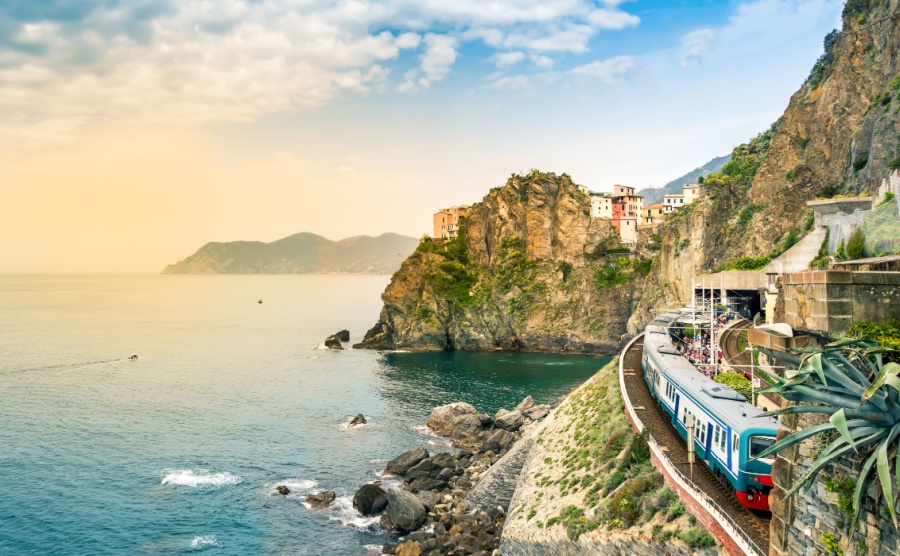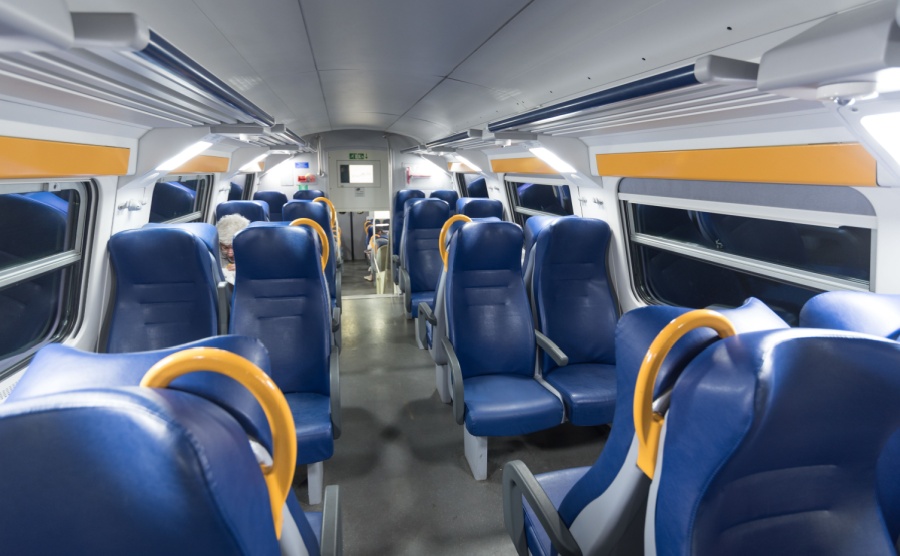If you’ve ever had your train slide onto a ferry in Messina, or travelled by rail along the eastern bank of Lake Como to Milan, you’ll know that Italy loves its trains, and with good reason. For home owners, traveling to their property in Italy by train, either from the UK or an Italian airport, is relatively simple, and getting even easier.
In Italy, €700 million is to be made available to purchase new electric and hydrogen trains, and renew regional railway lines. The Ministry of Infrastructure and Transport (MIT) say they are allocating the money for new trains across the country. Many regions will be getting several new trains, while Abruzzo and Puglia are set to get six each, Campania seven, Lombardy and Molise five, and Sicily four.
Already, 72% of the Italian railway network is electrified (compared to 38% in the UK). With sustainability in mind, the electric Frecciarossa 1000 high speed train, was the first train to get an environmental product certification. This means the environmental impact of the train will be calculated throughout its life.
Find homes in Italy via our property portal.
Investing in sustainability
In recent years, Italy has received billions of euros from the EU to promote economic and social development. This is being spent primarily on a sustainable transport network, energy transition, environmental protection and the preservation of cultural heritage.

The more relaxed way to get to your Italian home
The National Recovery and Resilience Plan (NRRP) is a package of investments and reforms prepared by the Italian government as part of “Next Generation EU”. Nearly €24 billion has been allocated to build more modern and sustainable roads, railways, ports and airports throughout the country.
High speed rail in Italy
The plan is to create a modern railway network to improve the mobility of citizens and goods. Top priority projects include delivering High Speed Rail for the lines: Salerno-Reggio Calabria, Naples-Bari and Palermo-Catania, and extending the Turin-Venice High Speed Rail to Padua. It should be noted that the biggest Italian train company is Trenitalia, which is state owned.
Other rail projects
Many sustainable mobility projects are already underway. These include new electric trains, tramways, and metro lines, such as Napoli’s metro lines 1 & 6, Palermo’s airport railway link and the new tram line in Florence.
Metro in Rome
Over the years, the construction of Metro line C in Rome has been slowed by funding delays and the archaeological excavations necessary. Today work is underway again and has reached another complex phase, requiring the digging of an 85-metre (280-foot)) deep retaining wall around a new metro station at Piazza Venezia. Archaeologists will be there to take objects that will eventually go in a museum within the station.
When finished, the underground tunnels will run under important heritage sites, such as the Colosseum and the Basilica of Maxentius, as well as churches, palazzi and the Vatican. This is a long complicated job, which they hope to complete before 2034.
More trains for the Summer
As trains are by far the least polluting means of transport, it makes sense to encourage travellers to leave their cars at home and take the train. This summer, Trenitalia has announced new destinations and routes to the seaside, mountains and the cities of art.
From Rome to Venice you save around 30 kg of carbon dioxide compared to a car and around 70 kg compared to a plane. Among the new routes being introduced are Lecce-Bolzano and Lecce-Bari-Reggio Calabria.
Many Italians and tourists in the north of Italy head to the southern beaches for their holidays. To drive from Milan to Lecce in Puglia takes about ten and half hours. Even longer in holiday traffic in an old fiat 500 with luggage strapped to the back. Starting in June 2024 at weekends you can now get a night train from Milan to Lecce. But how does the train compare to other forms of transport?
Comparing transport options
For example, the Intercity notte train (night train) on 15th June leaves Milan, Lombardy at 9.50pm and arrives in Lecce, Puglia at 9.30 the next morning. At time of looking the price was €74.50. However, offers are expected to appear on the new Frecciarossa night train.
In comparison the Flix bus leaves Milan at 9pm and arrives at Lecce at 10.35 the next morning for around €51.00. A flight to Brindisi takes 1hr 45 minutes, then it’s a little over an hour by bus to Lecce. Flights cost from €112 at time of looking. The Bus from the airport to Lecce costs from 3.
Why take the train?
Special offers on Trenitalia, such as two for the price of one, weekend discounts, family offers and free children’s tickets all help encourage people to take the train. Importantly, not having to drive means you can relax and start your holiday. You can play cards, read, watch something on your phone or sleep the whole way. Safe in the knowledge you aren’t pumping out car fumes into the beautiful countryside you see whizzing past the window.

The top deck of your Italian train (Luca Rei / Shutterstock.com)
If you aren’t going to live in Italy year-round, buying a property near a train station can be a smart move. You could save a lot of money by not needing to hire a car. Trenitalia are very aware that tourists also need buses and ships for their forward journey and so provide the possibility to book those through their app. aswell. Trenitalia offers a wide range of options and special deals.
Green transport options
When you leave the car at home, you will discover the advantages of using the train in combination with other sustainable modes of transport: Scooter sharing, car sharing, electric car rental in cities, even taking your own bike on the train. There are also some great cycle routes and hiking trails you can reach by train.
Bike on train
On intercity trains you can reserve a place for your bike for just €3.50. In the 3rd carriage there are six seats available, where you can attach your bike to a rack in a vertical position. There is even two charging points for electric bikes.
Alternatively, you can take a folding bike, scooter, or hoverboard on board with you for free. As long as you can tuck it out of the way and the overall dimensions are no bigger than 120 x 80 x 45 cm.
Scooter sharing
Electric scooters are available in Rome and Milan from a company called Cooltra. They are the leading scooter sharing service in Europe with a fleet of over 8,000 electric vehicles. Through the APP you can book and drive the available electric vehicles, and are charged only for the minutes you actually use it.
Electric car sharing
Vehicle-sharing with “enjoy” is active in the Italian cities of Rome, Milan, Florence, Turin, and Bologna. In these five cities, customers benefit from free access to the restricted traffic zones and at the end of use you can leave your vehicle parked for free in specific car parks, on the blue lines or at the railway stations of Milan Porta Garibaldi and Rome Termini. Maggiore E-City also have electric cars in Rome and Milan.
Train and ship
You can purchase your journey to the islands of Sardinia and Sicily to include the train and ship across to the island. Destinations you can get to by train and ship include Cagliari, Sardinia or Palermo, on Sicily, all departing from Naples. Smaller boats also travel to other islands.
Getting to Italy by train
If you can get to Dijon or Paris, you can then hop on a night train to Milan, Brescia, Bologna, Florence Padova, Venice, Verona or Vicenza with Thello trains. Children under 15 qualify for a child fare and small pets travel free. There are also daytime trains, if you prefer to see the view.
Trains to the cities
Bologna, Florence, Genoa, Milan, Naples, Rome, Siena, Turin, Venice and Verona are among the most popular Italian cities on good train routes. This summer 100 Frecciarossa train per day connect Milan and Rome, with 9 of those taking less than 3 hours. 70 Frecciarossa trains offer daily connections between Milan and Naples.
Trains to towns
However, it’s worth also looking at towns, which have train lines that go out to beautiful Italian villages. A good example is Lucca, from which you can catch a train to the villages of Barga and Gallicano for as little as €5. Trenitalia have also collaborated with “Borghi più Belli d’Italia” to suggest 26 beautiful Italian villages you can reach by train.
Trains to the seaside
This summer eight Frecciarossa trains per day will run between Milan and sunny Calabria. In addition, sixteen Frecciarossa and Frecciargento trains per day will run between Rome and Calabria. Over thirty Frecciarossa trains will run along the Adriatic coast, including two new daily trains from Milan to Pescara.
If you want to take the train to a traditional seaside town with fishing boats in the harbour, I’d suggest Monopoli in Puglia. A train line runs right along the coast between Bari and Brindisi. Both of which have airports.if you want a seaside resort with a large beach and lively nightlife, look at Rimini. Here the train station is right in the town.
When in Tuscany, you can get a train to the coast at Viareggio. Here you’ll find all the traditional beach holiday fun, from water sports to seafood restaurants. Alternatively, in the Liguria region there are trains that run all along the coast to many pretty villages and towns. These include the famous villages of the Cinque Terre. If you are looking for a bigger resort town, take a look at San Remo. The train station is conveniently located in the town centre and near the beach and you can reach San Remo from Nice in France, or Genoa, Italy.
Italy’s extensive train network connects major towns and cities. When combined with buses and ships you can reach every corner of the country. Ticket prices are very reasonable to encourage people to use cars less and produce less pollution.










